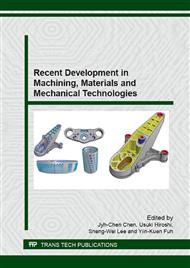p.450
p.456
p.461
p.468
p.473
p.479
p.484
p.490
p.496
Investigation of Crack Generation in a Notch during Diameter-Enlargement Working Method Processing
Abstract:
We have proposed a new cold processing method to enlarge the diameter of a short section of a metal shaft using a combination of a cyclic bending load and an axial compressive load that is lower than the yield stress of the sample material. We call this cold processing method the diameter-enlargement working method, and refer to the enlarged section of the processed shaft as the diameter-enlargement section. The processing method produces large plastic deformation, and its key features are as follows: the diameter-enlargement deformation progresses easily under a low axial compressive load at room temperature and the processed part exhibits little temperature increase. However, a crack is generated in the notch near the diameter-enlargement section during processing, and the cause is not yet clearly understood. Therefore, we conducted processing experiments to clarify the crack generation conditions, and simulated the working process using the finite element method to investigate the behaviors of stress and strain during processing. Furthermore, we calculated the low-cycle fatigue damage in the processed shaft using the Manson–Coffin expression. This study clarifies the mechanism of crack generation during processing and evaluates the fatigue strength of the processed part.
Info:
Periodical:
Pages:
473-478
Citation:
Online since:
July 2015
Authors:
Price:
Сopyright:
© 2015 Trans Tech Publications Ltd. All Rights Reserved
Share:
Citation:


